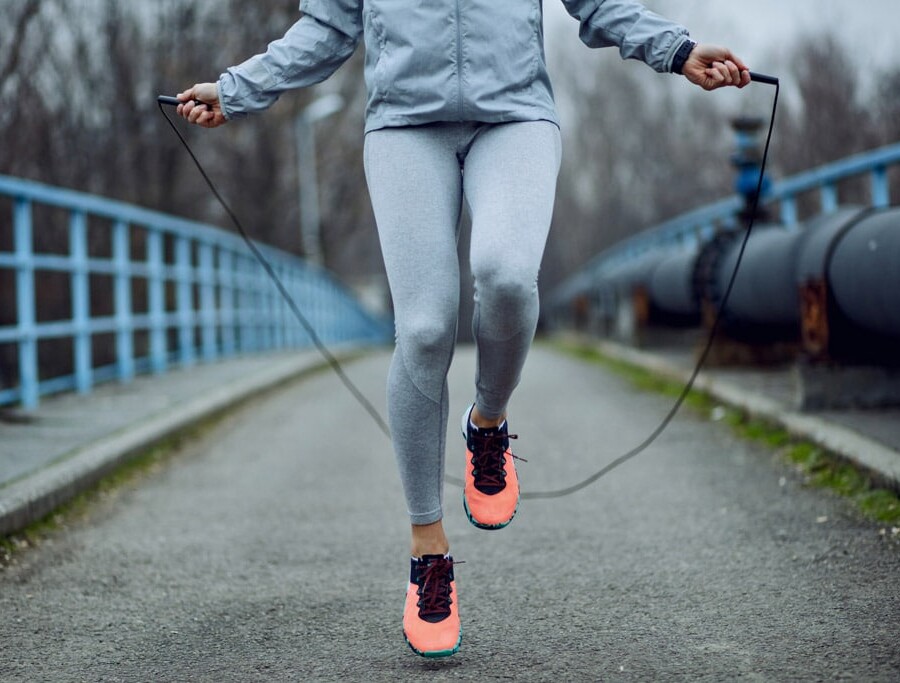Fitness and Performance
Skipping: How to avoid injury and shin splints

Skipping is an activity that was once commonly associated with school playgrounds and pro boxing rings. However, the last year has seen it boom in popularity as brilliant Brits like Lauren Flymen (IG @lauren.jumps) have sought fun new ways to keep fit throughout lockdown.
There’s a good reason behind skipping being ranked as a top training tool for boxers, athletes and celebs like Jennifer Garner and Kate Hudson. “It can help reduce the risk of injury, strengthen bone density, build shoulder and calf strength, improve ankle, knee and pelvis stability, enhance cardiovascular health and burn calories”, says Bodyset Senior Physiotherapist Francesco Rizzo. And to achieve all of that you only need one piece of equipment – a jump rope!
Like any sport, skipping can cause injury. However, skipping injuries can often be prevented with the right knowledge and preparation. We spoke to Francesco about how to avoid common skipping injuries like shin splints, ankle pain and stress fractures. Here’s what he had to say…
Warm up
With any intense activity, it is beneficial to get into the practice of warming your heart and muscles up. Before you start your skipping routine, do some warmup exercises for 5-10 minutes to help transition your body from a resting state to an active state. You can warm up with your jump rope by skipping slowly, or get your body moving with squats, jumping jacks, pogo jumps, lunges, push-ups, and shoulder rotations.
Don’t skip stretching
Dynamic stretches should form an important part of your warmup routine. Try loaded calf raises to warm your calf muscles. Roll out your legs and hips with a foam roller and place one foot at a time on a tennis or lacrosse ball to loosen your feet.
And don’t skip the cool down! Just 5 minutes of static stretching after a jump rope workout can help your muscles recover, strengthen, and even improve your next performance. During a workout, muscles go through numerous contractions which leave them in a shortened state. Stretching them back to a relaxed state helps your body reduce lactic acid, regulate blood flow and reduce stiffness. Try standing calf stretches, standing hamstring stretches and chest stretches.
Choose a softer surface to skip on
Try to avoid skipping on hard surfaces like concrete. You are most prone to injury at the point of landing. A softer surface such as a rubber mat or wooden floor can help to reduce the pressure on your muscles and ligaments.
Stay low /Skip low to the ground
The higher you jump, the further you have to land. Jumping higher only increases the pressure on your body which can lead to torn ligaments and shin splints (tibial stress syndrome). The term ‘shin splints’ refers to a pain that can be felt along the shin bone (tibia). This is caused by repeated stress on your shinbone and the inflammation of connective tissues that attach your muscles to your bones.
Listen to your body
If you find yourself experiencing sharp pain or a dull ache that won’t go away, be sure to listen to your body and rest. If the pain continues then get in touch and one of our expert physiotherapists will advise you on the best treatment plan for injury recovery and prevention.
Choose your skipping shoes wisely
To avoid injury, we advise that you do not skip in bare feet – even if you used to do it as a child! Skip in well-fitted running shoes or trainer fitted with shock absorbers that support your ankles and cushion your feet.
Rest between skipping sessions
If you are new to skipping, then try not to skip every day (however good it feels)! Your muscles and ligaments will need time to adjust to a new set of repeated movements. Rest is important for muscle recovery and growth. On your days off take time to stretch and walk to stay active.
Skipping has a multitude of health benefits. It is fun do to in the springtime sun, and it can be practised indoors on rainy days too!
If you are pregnant or suffering from underlying health conditions, we advise that you always speak to your doctor before embarking on a new activity. If you are already suffering from ankle, hip or knee pain, we advise that you speak to an expert physiotherapist before you start your skipping journey.
We hope you enjoy skipping your way out of lockdown!